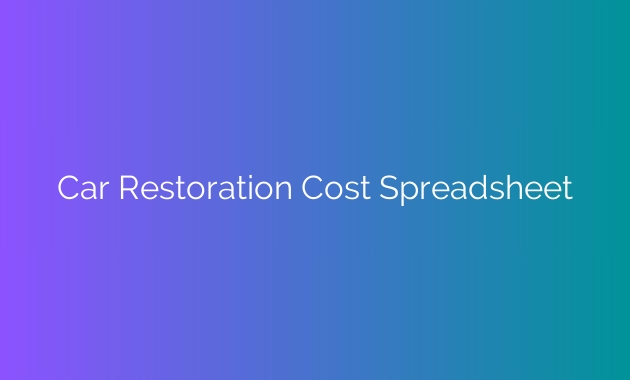Car Restoration Cost Spreadsheet
Car Restoration can be an exciting and rewarding project for car enthusiasts, but it can also be a costly endeavor. Without proper planning and budgeting, costs can quickly spiral out of control. This is where a car restoration cost spreadsheet can come in handy. In this article, we will explore the importance of using a spreadsheet to track and manage restoration costs, as well as provide some tips on how to create one effectively.
Why Use a Car Restoration Cost Spreadsheet?
When embarking on a car restoration project, it is crucial to have a clear understanding of the expenses involved. A spreadsheet allows you to keep track of every expense, from the initial purchase of the vehicle to the smallest replacement part. By documenting each cost, you can easily monitor your progress and ensure that you stay within budget.
Furthermore, a spreadsheet provides an organized and systematic approach to managing your restoration costs. It allows you to categorize expenses, such as engine repairs, bodywork, paint, and interior restoration, making it easier to analyze and evaluate your spending patterns. This level of detail can be immensely helpful in identifying areas where you can potentially save money or make adjustments.
Creating a Car Restoration Cost Spreadsheet
Now that you understand the benefits of using a car restoration cost spreadsheet, let’s delve into the steps involved in creating one:
1. Start by opening a spreadsheet program, such as Microsoft Excel or Google Sheets.
2. Create column headers for the following categories: Date, Description, Vendor/Supplier, Cost, and Notes. These headers will serve as the foundation for documenting your expenses.
3. Under the Date column, enter the date of each transaction or expense.
4. In the Description column, provide a brief description of the item or service purchased.
5. Use the Vendor/Supplier column to specify the name of the vendor or supplier from whom you made the purchase.
6. Enter the cost of each expense in the Cost column. It is essential to be as accurate as possible to maintain an accurate overview of your total expenses.

7. Utilize the Notes column to add any additional information or details regarding the expense, such as part numbers or specific notes about the purchase.
8. As you progress with your restoration project, continue adding new rows to the spreadsheet for each new expense.
9. Regularly review and update your spreadsheet to ensure it reflects the most recent expenses accurately.
Tips for Effective Spreadsheet Management
To make the most out of your car restoration cost spreadsheet, consider implementing the following tips:
1. Categorize your expenses: By grouping similar expenses together, you can easily identify areas where you are spending the most money.
2. Track labor costs: Don’t forget to include the cost of labor in your spreadsheet, especially if you are hiring professionals for certain aspects of the restoration.
3. Account for unexpected expenses: It’s essential to allocate a portion of your budget for unexpected costs that may arise during the restoration process. This will help you avoid any financial surprises down the road.
4. Regularly review your budget: Take the time to review your spreadsheet regularly and compare your actual expenses against your projected budget. This will help you identify any discrepancies and make necessary adjustments.
5. Use formulas and calculations: Spreadsheet programs often include powerful functions and formulas that can automate calculations, such as totaling expenses or calculating averages. Take advantage of these features to save time and improve accuracy.
Conclusion
A car restoration cost spreadsheet is an invaluable tool for effectively managing and tracking restoration expenses. By maintaining a detailed record of all costs, enthusiasts can ensure that their projects stay on budget and within their financial means. Implementing the tips mentioned in this article will further enhance your spreadsheet management skills and contribute to a successful car restoration project.
Frequently Asked Questions about Car Restoration Cost Spreadsheet
Q1: Can I use a free spreadsheet program to create my car restoration cost spreadsheet?
A1: Absolutely! There are several free spreadsheet programs available, such as Google Sheets and LibreOffice Calc, that offer similar functionality to paid programs like Microsoft Excel.
Q2: Should I include taxes in my restoration cost spreadsheet?
A2: Yes, it is advisable to include taxes in your spreadsheet to accurately reflect the total cost of each expense. It is essential to be transparent and thorough when tracking your expenses.
Q3: How often should I update my car restoration cost spreadsheet?
A3: It is recommended to update your spreadsheet regularly, ideally after every expense or at least once a week. This will ensure that your records are up to date and provide an accurate overview of your restoration costs.
Q4: Can I share my car restoration cost spreadsheet with others?
A4: Yes, you can share your spreadsheet with others, such as fellow car enthusiasts or professionals assisting with your restoration project. Most spreadsheet programs offer options for collaboration and sharing.
Q5: Can I use my car restoration cost spreadsheet as a reference for future projects?
A5: Absolutely! Your spreadsheet can serve as a useful reference for future projects, allowing you to make more accurate budget estimates based on previous restoration experiences.
